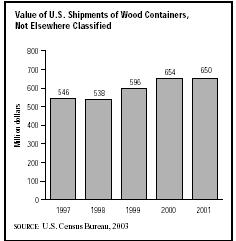SIC 2449
WOOD CONTAINERS, NOT ELSEWHERE CLASSIFIED
This industry classification includes companies that primarily make wood containers, not elsewhere classified, such as cooperage, wirebound boxes and crates, and other veneer and plywood containers. Companies that primarily make tobacco hogshead stock are in SIC 2421: Sawmills and Planing Mills, General and those making cooperage stock are in SIC 2429: Special Product Sawmills, Not Elsewhere Classified.
NAICS Code(s)
321920 (Wood Container and Pallet Manufacturing)
This classification covers makers of nearly any wooden container that is not either a pallet or a nailed or lock corner box. Many containers in this classification are made from staves, heads, and hoops—a group of products called cooperage. Containers made in this way include barrels, storage vats, and buckets. Tight cooperage refers to containers used to store liquids, such as wine casks, beer barrels, or hot tubs. Containers built to hold solid materials are called slack cooperage. Cooperage is usually built in one facility from pieces constructed elsewhere.
The wood used for staves varies depending on the material to be shipped or stored. For instance, high quality white oak is used for aging bourbon, while seafood is often shipped in smaller kegs made of southern yellow pine. Hoops can be made from steel, wire, or wood.
Wirebound boxes are another part of this industry classification. About 60 percent of wirebound boxes are used for agricultural clients, such as fruit and vegetable growers. The military and private industries also use wirebound boxes. Unlike coopered container producers, wirebound box makers often process their own lumber or veneer. The technology for making wirebound boxes is relatively simple: box parts move down a conveyor belt,

wire is stapled to the box, then a fastening machine binds the wire ends together.
The top two industry leaders in overall sales were large corporations that integrated wood container production into their own operations to create economies of scale. CNF Transportation Inc. of Palo Alto, California, which used wood containers in its trucking operations, led the industry with over $5.1 billion in 2003 sales. Brown-Forman Corp. of Louisville, Kentucky, which used wood containers to age and transport its distilled liquors, came in second in the industry with sales of over $2.3 billion for its fiscal year ended April 30, 2003. The third place company in the industry, Greif Inc., formerly Greif Bros. Corp., of Delaware, Ohio, generated sales of $1.9 billion for its fiscal year ended October 31, 2003, focusing primarily on container manufacturing.
The remainder of the industry leaders, which were smaller companies with lower revenues, included Sonoco Products Co. Baker Div. of Hartselle, Alabama; Calpine Containers Inc. of Pleasant Hill, California; Semac Industries Inc. of Millersburg, Ohio; and Marvil Package Co. of Wilmington, North Carolina.
According to the latest figures published by the U.S. Census Bureau, more than 200 establishments operate in this category. Industry-wide employment totaled roughly 5,600 workers receiving a payroll of almost $110 million. Of these employees, an estimated 4,600 put in almost nine million hours to earn wages of just over $75 million. In 2001, overall shipments for the industry were valued at more than $650 million, compared to $546 million in 1997.
Although the value of miscellaneous wood container shipments grew steadily throughout the late 1990s, from $546 million in 1997 to $654 million in 2000, shipments in 2001 declined to $650 million. This was partly due to competition from containers made without wood, such as corrugated paperboard and plastic. Also, since containers that clients want vary in size and shape, their production can not be automated as easily as a standard-sized product like wood pallets. Demand for quality wood containers probably will not fade, however, regardless of non-wood containers available. This, coupled with weak foreign competition, hints at a positive future for the U.S. wood container industry.
Further Reading
U.S. Census Bureau. "Statistics for Industry Groups and Industries: 2000." February 2002. Available from http://www.census.gov/prod/2002pubs/m00as-1.pdf .
——. "Value of Shipment for Product Classes: 2001 and Earlier Years." December 2002. Available from http://www.census.gov/prod/2003pubs/m01as-2.pdf .
——. "Wood Container and Pallet Manufacturing." 1997 Economic Census-Manufacturing. 20 February 2000. Available from http://www.census.gov/prod/ec97/97m3219d.pdf .
Comment about this article, ask questions, or add new information about this topic: